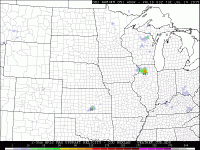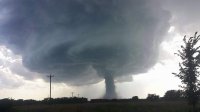Dan Robinson
EF5
Monday is the 11-year anniversary of the Roanoke, Illinois F4, and it's interesting that we will have a setup that shares some similarities with that day in 2004 - in the exact same area. A potent shortwave trough imbedded in northwest flow will overspread extreme instability across Illinois and Indiana on Monday afternoon. A linear storm mode/derecho event should quickly evolve. But, as with the Roanoke event, boundary interactions early in storm evolution could easily yield a couple of significant tornadoes.
The main drawback I see with Monday's event is weak surface flow, but the extreme instability in place should compensate. The 2004 event also had rather weak and ill-defined surface flow. The 2004 event also had a more diffluent upper air pattern than models are indicating for Monday.
http://www.spc.noaa.gov/exper/archive/event.php?date=20040713
The main drawback I see with Monday's event is weak surface flow, but the extreme instability in place should compensate. The 2004 event also had rather weak and ill-defined surface flow. The 2004 event also had a more diffluent upper air pattern than models are indicating for Monday.
http://www.spc.noaa.gov/exper/archive/event.php?date=20040713


